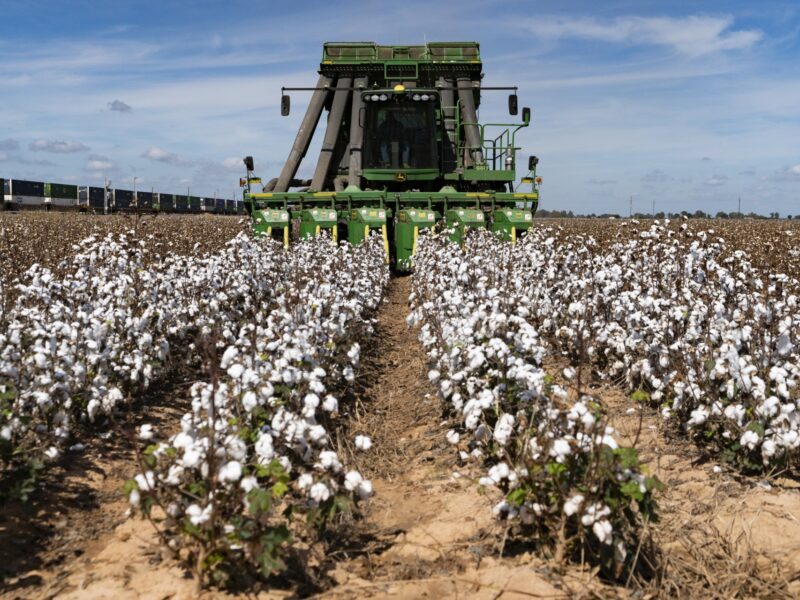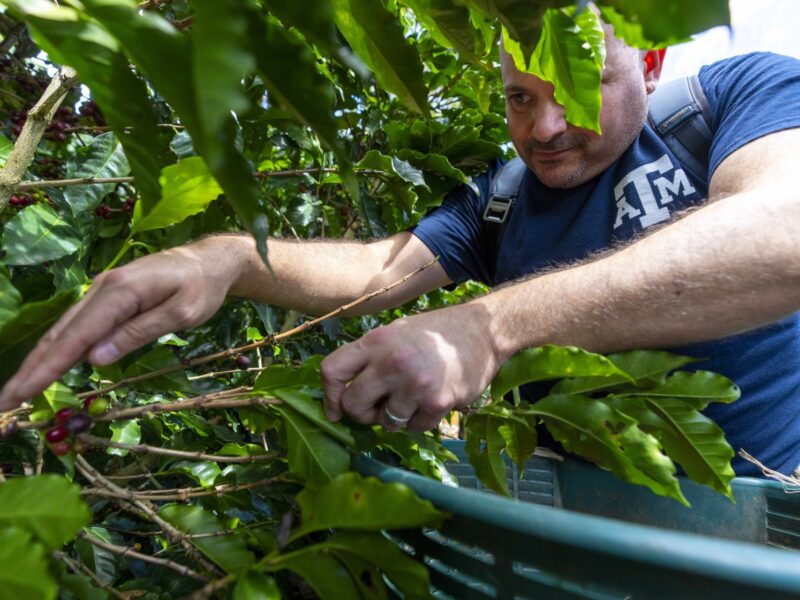Poultry Science Professor Finds Niche In Commercial Duck Research
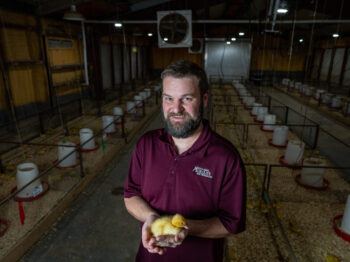
When we think of ducks in Texas, most people probably think about the ducks in the pond at their local park or the wild, migratory birds that have waterfowl enthusiasts up at the crack of dawn to stand for hours in frigid bodies of water to hunt.
But those are not the ducks Dr. Greg Archer, associate professor and Texas A&M AgriLife Extension Service poultry specialist in the Texas A&M College of Agriculture and Life Sciences Department of Poultry Science, thinks about.
When Archer thinks of ducks, he thinks of commercial ducks, raised for meat and eggs. He also thinks of the scarcity of information available to producers and scientists, due to the lack of duck research being conducted.
“Along with being in AgriLife Extension, my background is in welfare and stress physiology,” said Archer. “When I got to Texas A&M, I was trying to branch out. We had a lot of people doing research on chickens at the time, so I wanted to look at other poultry.”
Commercial Ducks
While at a poultry industry conference shortly after joining the department, Archer connected with representatives from Maple Leaf Farms, one of the largest commercial duck producers in North America. They discussed the lack of research being done on ducks and the need for it.
Having previously worked on a project with Whole Foods while at the University of California, Davis, Archer was no stranger to ducks.
He saw a need and knew he could make an impact on a growing industry.
The U.S. commercial duck industry is primarily located in the Midwest and the East Coast. Most ducks and eggs produced are exported to China and European countries where duck is a more popular source of protein. According to the U.S. Department of Agriculture, Americans consume 0.34 pounds of duck per person per year. By comparison, the average American consumed 100.6 pounds of chicken in 2022, according to the National Chicken Council.
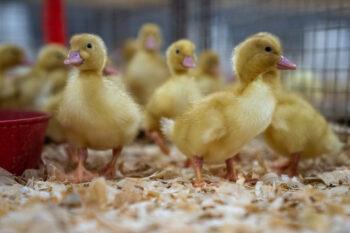
Based on consumer demand, Archer said the majority of poultry research dollars in the U.S. are funneled toward the chicken industry as opposed to ducks. As a result, he has had to do the legwork to fund his own projects or work with companies and producers on in-kind donations.
“I’ve had donations of eggs or ducklings from the industry,” he said. “The in-kind donations have helped, but funding for most of our projects has been in-house. I haven’t really gotten any federal money or anything because there’s not a lot of funding out there for duck research.”
According to Archer, this has left duck producers in a bit of lurch, having to base practices on what is done in chicken production. A common misconception is that chickens and ducks are the same — what works for one should work for the other. But that is not always the case.
And while chickens may be the more popular protein source, they cannot beat ducks when it comes to efficiency.
“You can get a full-grown duck to market size of 8 pounds in 35 days,” said Archer. “Whereas chickens reach market size of 6 pounds in 42 days. So, ducks are a much bigger, faster growing bird.”
Lighting The Way
Archer has done many poultry lighting studies through the years and is one of the only researchers in the country conducting such research. He continues lighting projects because the industry is trying to grow and modernize their production practices to be more efficient while also keeping the welfare of the ducks at the forefront.
Like chickens, commercial ducks are raised indoors. Many farmers who contract with the commercial producers are Amish, so their ducks are raised in natural light conditions or under kerosene light. Archer says there is not much literature on how artificial lighting technologies could affect ducks. Thus, Archer’s first project on them at Texas A&M focused on lighting and what hue ducks perform best under.
“Over time, we have found that broiler chickens tend to grow better under blue light because it makes them rest, which in turn enhances their growth performance,” said Archer. “We thought that should be the same for ducks. And when we did that, we actually found out the spectrum of light blue light has a negative effect on them. Their stress hormones went up and they tended to get sick more often.”
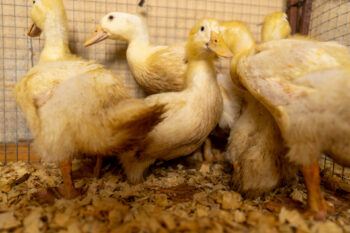
Researchers found ducks perform better under a redder light, similar to layer chickens. He credits this to their evolution over time as ducks are naturally in more open, exposed areas near bodies of water.
Another project he is currently working on is to see whether ducks prefer one color of lighting over another.
“We want to see which lights they actually prefer versus which ones we have seen them grow better under to see if the ducks themselves would choose a certain type of light to live under,” said Archer. “As I teach in my welfare class, sometimes animals don’t always choose the best welfare conditions for themselves, and we have to determine when to step in.”
Filling The Knowledge Gap About Ducks
Archer said one of the fun things about working with an industry where there isn’t much known is the diversity of research opportunities available. In addition to the lighting trial, he is also studying how probiotics can affect growth and an array of animal welfare parameters.
“We want to see if probiotics populating the gut can stop bad bacteria from migrating,” he said. “Ducks can have a leaky gut, which allows bacteria to travel down to their joints and cause lameness.”
Archer and his students are also doing fear testing related to probiotics. He said there is a lot of research in humans and rodents to see if probiotics can alter moods. They are doing similar tests in ducks to see if this affects their behavior and fear response.
Additionally, they will look at how probiotics may relieve some of the effects of heat stress on ducks. Heat stress can cause campylobacter, salmonella and other bad bacteria to leak from their guts and cause issues for the birds. Archer and his team will mildly heat stress the ducks to see if the probiotics will keep this from happening and keep the ducks growing efficiently.
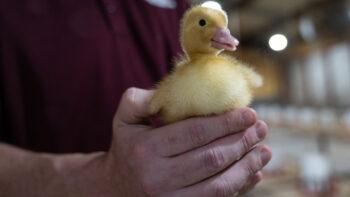
Upcoming studies will focus on enzymes. Archer wants to see if adding enzymes to the diet can counteract the negative effects of less nutritious or lower quality feed. This could potentially allow producers to utilize alternative feedstuffs that may not normally be part of a duck’s diet but may be cheaper or more readily available. The addition of enzymes could help the ducks better digest the alternative food source.
Past research from Archer examined the effects of light exposure on eggs during the incubation period and worked with companies on proper dosages for products being produced for ducks and more.
“Ultimately, my research is very applied and diverse in terms of what we do,” said Archer. “I’m trying to do things that will benefit stakeholders and the commercial duck industry and show them how they can improve things either through management or feeding practices.”
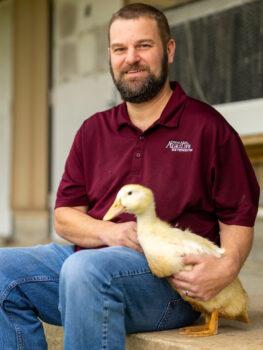
Providing Opportunities, Regardless Of Outcomes
Ducks have provided a unique learning opportunity not only for Archer, but his students as well.
“A lot of my students didn’t know there was a commercial duck industry out there,” he said. “I enjoy exposing them to that while also trying to grow their problem-solving mindset when they see an issue or an area that is lacking in information.”
And while every project may not have the expected outcome, it is all valuable data.
“I try to teach my students that when we’re testing something, if it works, it works, and if it didn’t, then that’s also knowledge gained,” said Archer. “Or if we find out that there’s no difference between things, or for example, in the lighting preference study that ducks don’t care what light they’re under, that’s also more data out there. Some of what we do is just adding to the knowledge base.”
Archer said duck producers can research lighting and other things and may find some literature, but there will not be nearly as much available as there is for chickens or other species.
“That’s why I got into duck research and lighting specifically, because there’s a gap and there was a need for someone to fill it,” he said. “Even though the commercial duck industry in the U.S. is not using modern technology as widely as it could, that is not going to be the case forever. This is a way for me to expose my students to unique opportunities and help the industry grow.”
This article by Maggie Berger originally appeared on AgriLife Today.

